Kaldheim Storytime, Part 1
The last two weeks, I told the story of Kaldheim's design (part 1 and part 2). Today, I'm going to be telling some card-by-card design stories.
Alpine Meadow, Arctic Treeline, Glacial Floodplain, Highland Forest, Ice Tunnel, Rimewood Falls, Snowfield Sinkhole, Sulfurous Mire, Volatile Fjord, and Woodland Chasm
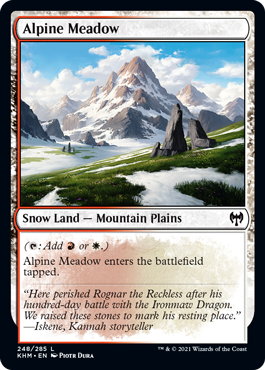
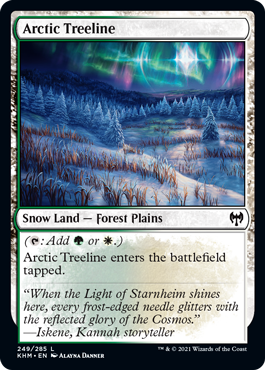
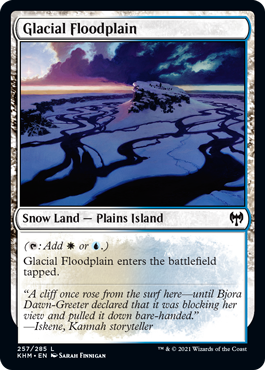
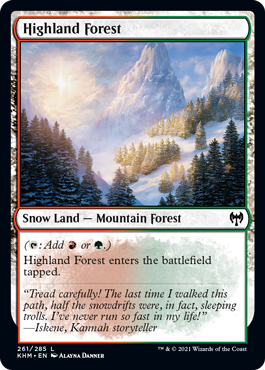
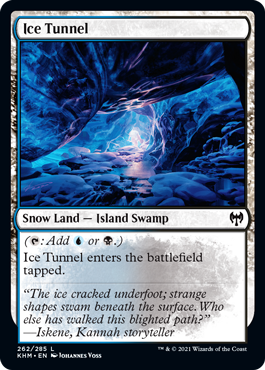

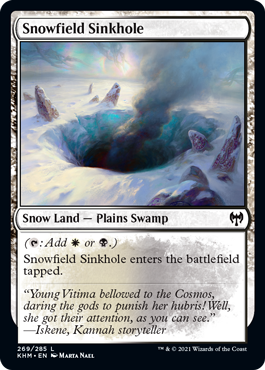
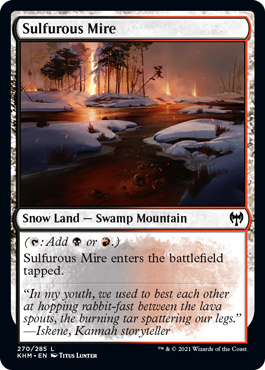


Coldsnap had a cycle of five ally color snow dual lands that entered the battlefield tapped. The original idea was to reprint those in Kaldheim and then make the enemy color versions. The problem with this plan was that some of the lands (such as Tresserhorn Sinks) had names that were tied to Dominaria and weren't a good fit for Kaldheim. Dave Humpherys, Kaldheim's lead set designer, came up with the idea of adding the basic land types to these cards, which would allow them to have different names. We've long learned that dual lands that enter the battlefield tapped have some room for something extra. Dave and the Play Design team decided that having the snow supertype (which is more plus than minus—more on this next week) plus the basic land types was acceptable.
At that point, everything seemed to be lining up. Kaldheim has ten words each connected to a different two-color combination. The snow dual lands were a ten-card cycle. Obviously, each one could show off their respective world. One small problem. Snow was not necessarily a perfect fit for every world. Immersturm (the black-red world), for example, was a land of fire. The Creative team worked hard to figure out how to find snow in each realm (and in the end decided that the dual lands could show a place of the appropriate color even if it wasn't technically the realm associated with the colors). The lands were also given more general names so they could be used on a different snow-related plane sometime in the future.
Alrund, God of the Cosmos // Hakka, Whispering Raven

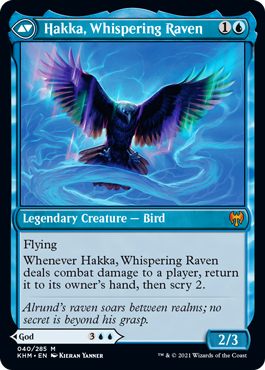
Here was our first stab at doing our version of Odin and his raven:
Hrafin the Hossip
2UU
Legendary Creature — God
*/*
When you cast this spell, name a card. Reveal the top card of your library. If it's the named card, draw two cards. Otherwise, draw a card. CARDNAME's power and toughness are each equal to the number of cards in your hand.
Hrafn's Ravens
U
Creature — Bird
1/1
Flying
Whenever CARDNAME attacks, scry 1. When CARDNAME dies, if you control a God, draw a card.
The idea behind our initial design was that if you drew it early, you would cast the Raven to help you find a second copy so that you could cast "Odin." The scrying would allow you to correctly name the card when he entered the battlefield.
Alrund went through three main changes. One, he went from a */* creature to a 1/1 that got +1/+1 for each card in your hand. Two, the naming of the top card of your library changed from an enters-the-battlefield effect to a repeatable trigger that happened at end of turn. Three, instead of naming one card, you now name a card type and have the potential to draw two cards. All these changes made the card more impressive and exciting to play.
The Raven kept its scrying ability but was changed so that it ended up back in your hand, allowing you to play it early and then later play it as Alrund when you got to enough mana. I'm happy that the key flavor made it all the way from first design to print.
Ascendant Spirit
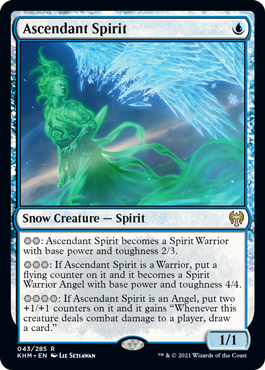
Over the years, we've designed a lot of Magic cards, but not all Magic cards are equal. Occasionally, we make what I call a "template" card, that is, a card that is so cool and memorable that it inspires us to make more cards like it. It essentially becomes a template for cool cards in the future. You usually don't set out to make a template card, it's just a lightning-in-a-bottle experience that happens from time to time. One such template card was designed by Brian Tinsman in Eventide called Figure of Destiny.
This card has inspired numerous things, including the level-up mechanic in Rise of the Eldrazi. Another thing it inspired was this card (what I call a "relic" card—templates inspire relics). We were looking for things to do with snow mana, and somebody had the idea of crossing it with Figure of Destiny. Ascendant Spirit had to figure out its flavor (Figure of Destiny-type cards gain creature types as a way to gate which activation you can use), but the Spirit becoming a Warrior then becoming an Angel came naturally as the card got designed.
Calamity Bearer
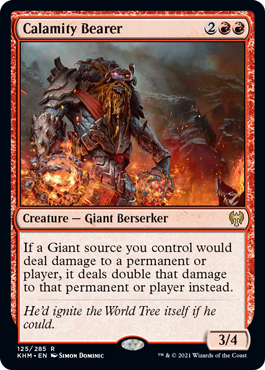
This card uses a very good tribal design trick. Create a tribal ability and then put it on a creature of that tribe such that its ability can work on itself. For example, Calamity Bearer doubles the damage of Giants, but it's a Giant, so its ability can work on itself. The nice thing about this design is that it can work in isolation (you'll still play this card if it's your only Giant) and as the center of a tribal design (play Calamity Bearer with a lot of other Giants). One of the problems with tribal cards is that they can often be unusable if not played in the proper tribal deck. Tricks like this allow the card to have some use outside its niche.
Cyclone Summoner
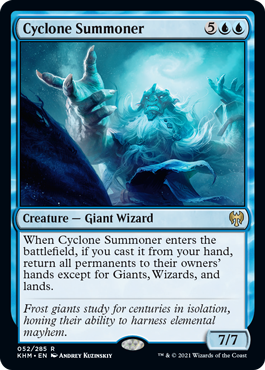
R&D likes doing tribal effects. They're popular with most players and they're very flavorful. The challenge is finding new and different ways to make tribal effects. There's only so many times you can do "NAMED TRIBE gets +1/+1." Cyclone Summoner shows two different areas design has been playing around with in the last few years (in larger volume, there are cards that did some of this long ago).
- Batching
This is when we take a group of things and connect them together mechanically. Sometimes we give them a word (such as historic—this usually happens when there's a bunch of them), but other times we just list them out. This allows us to do things like inspire decks that use multiple creature types together or combine certain creature types with certain other subsets of cards. For instance, Cyclone Summoner encourages you to make a deck with both Giants and Wizards.
- Negative Tribal Effects
Normal tribal effects help a certain creature type (or combination of creature types). Negative tribal effects do something, usually bad, to everything but the relevant creature types. It still encourages building tribal decks, but in a different way than the traditional tribal effects.
Doomskar
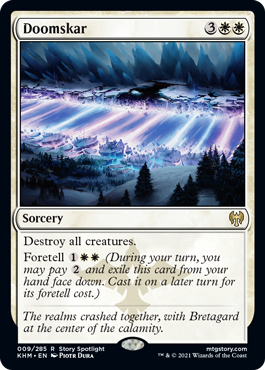
Let me tell you about the connection between the card Doomskar and the film series Star Wars. You see, when I talked about foretell's design last week, I glossed over an interesting part of the story. I figured today, as I'm telling stories, I had an opportunity to fill you in on an interesting aspect of foretell's design.
Many years ago (somewhere around 19 to 20 years), I was called into the office of who at the time was my boss's boss, a man named Jim Lin. He informed me that Hasbro had just made a deal with George Lucas to acquire the licensing rights to Star Wars. One of the offshoots of this deal was that Wizards was going to make a Star Wars trading card game. Richard Garfield was going to lead the design team to create the game (which I would be on) and then I'd be leading the design of the first set. If anyone has ever heard me tell my story of visiting Skywalker Ranch, this is how it happened. (Two-sentence recap—I had to read the script of Attack of the Clones to design the set and that was only possible to do at Skywalker Ranch. It was a bucket list event for me.)
In the game, to match the flavor of the movie, there were three zones where battles were fought—space, ground, and character. You won by gaining control of two of the three zones. The game involved you playing cards representing various fighting elements to different zones. The resource system of the game gave you points that you could spend to play the cards. In order to have larger items, there was a build zone where you played the card, allowing you to pay for cards over time.
I enjoyed how the build zone played in the Star Wars TCG, so I made a mechanic called layaway that mimicked it. You played a card face down in exile, and then for every mana you spent, you could put a counter on it. You were able to cast it from exile at any time (well, anytime that spell type could be played), and its mana cost was one less for every counter that had been placed on it. Because this only lowered the generic mana, it made sure you were still paying the proper color for the spell when you cast it. Additionally, you could overpay ahead of time as a way of bluffing what the card was.
It was a fun mechanic, but it was complicated and involved a lot of physical manipulation and didn't quite fit the set I was working on (I honestly don't even remember what set it was—this was almost 20 years ago), so I did what I do with all the cool mechanics that don't quite fit, I put it in mothballs and waited to find a spot where it fit. (Energy is a popular example of a mechanic I mothballed only to find a home for it years later.) Occasionally, I'd bring it out when we were looking for mechanics, but it never found its spot.
Flash forward to Kaldheim vision design. Ethan brings up the idea of us doing a mechanic that captured the flavor of Omens, as omens are a big deal in Norse mythology. When he described what he wanted, I said, "Oh, that sounds like layaway," so I brought it out of mothballs for us to discuss. What resulted was us sort of smashing Ethan's idea and layaway together to make a cleaner version than either. And that is how Stars Wars helped foretell and ultimately Doomskar come to be.
Egon, God of Death // Throne of Death

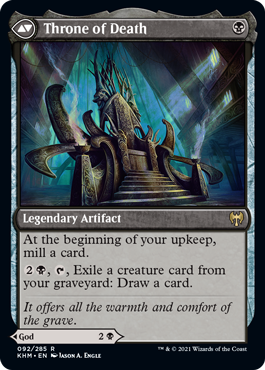
The Norse God of Death is Hel (called Hela in Marvel's comics and movies). How could we not take our stab at the God of Death? Here was our earliest version:
Hel the Covetous
3B
Legendary Creature — God
2/5
Deathtouch
Whenever a creature an opponent controls dies, draw a card.
Gates of Hell
2B
Artifact
Creature cards can't leave opponents' graveyards.
Both cards went through a lot of changes. Let's start with Hel. He kept deathtouch all the way to print, but his main ability changed to "Whenever a creature an opponent controls dies, draw a card. Whenever a creature enters the battlefield under your control, if it entered from your graveyard or was cast from your graveyard, draw a card." His main ability changed again, this time to "If you would draw a card, return a card at random from your graveyard to your hand instead. If you can't, sacrifice CARDNAME. If a card would be put into your graveyard from anywhere, exile it instead." The next major change was to the printed version. Also, along the way, he kept changing in size from a 2/5 to a 2/4 to a 5/4 and ultimately to a 6/6.
Gates of Hell soon gained the ability "3B, Sacrifice CARDNAME: Put onto the battlefield under your control all creature and/or planeswalker cards in all graveyards that were put there from the battlefield this turn." Then it changed to exile any creature or planeswalker controlled by an opponent that died and you could spend 3B and sacrifice it to return a creature that had been exiled by it or a creature card in your graveyard to the battlefield. It then changed to its printed version except it started at first milling two cards. That ended up being too much and was moved back to milling one card. I believe it changed from the Gates of Hell to the Throne of Death around the time of its change to the milling version.
Esika, God of the Tree // The Prismatic Bridge
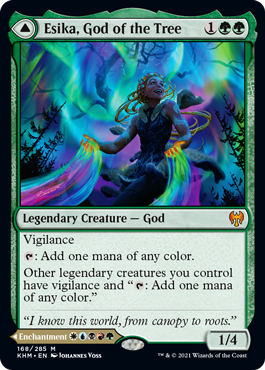
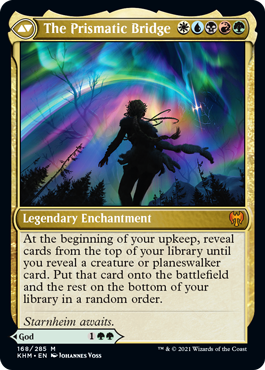
In the design meeting where we first came up with the idea of the Gods all being MDFCs (modal double-faced cards), we made a list of all the combinations we had to do. Thor and his hammer. Odin and his Raven. Loki and his true form. (We had the idea of Tibalt pretending to be the trickster god very early.) And of course, we had to do Heimdall and his rainbow bridge. (And yes, I understand in the Marvel Cinematic Universe, they separate the rainbow bridge and the Bifrost.)
We designed the rainbow bridge first. It had to be a five-color enchantment that did something splashy. That was a no-brainer. Clearly, it brought things from other places. A couple ideas got thrown out, but then someone said, "What if it cascades for a creature every turn?" And with that, we were done. The only thing that changed during set design is that they made it a creature or planeswalker for flavor. Play Design contemplated removing "planeswalkers," but decided it was okay.
The other side, though, went through a lot of changes. The first version (the one we made during vision design) was this:
Heimdall, Protector of the Realm
2W
Legendary Creature
1/5
Reach
Can block any number of creatures during combat.
Heimdall's main role is to protect Axgard from outsiders, so we gave him a very protective ability. His name quickly changed from Heimdall, Protector of the Realm to Vardi the Watchful. He also changed from white to green and officially become a God at this point. His ability was then changed so that he and all Gods gained reach and "can block any number of creatures." Reach was then changed to vigilance, as it seemed flavorful that the character was vigilant.
At this point, Set Design realized that while each side of the card was flavorful, they weren't really playing well with one another. One of the things we liked about the MDFC Gods was that you could play the second side if the legendary side was already on the battlefield. This seemed like a nice way to lessen the pain of drawing a second copy of a legendary creature. This led Set Design to change the "can block any number of creatures" to "T: Add one mana of any color." Then, when the card got concepted, the card moved away from being a protector to more of a creature of nature. It also took on Freya's Chariot that was pulled by cats (at one point, that was the backside of a Freya card).
Elements of Heimdall (the protector part with the sword) got moved over to Halvar, God of Battle and his Sword of the Realm. As often happens when we use a source as inspiration, certain aspects can get stretched over multiple cards.
Fynn, the Fangbearer
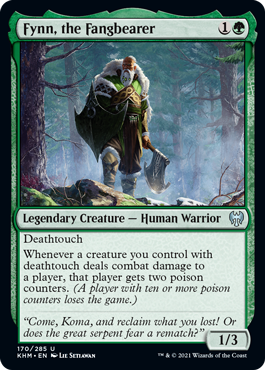
When poison was first introduced to the game (in Legends) it just appeared on two cards. Most of its appearances over the next few years were on single cards that appeared in sets. When I brought it back after a long hiatus in Scars of Mirrodin (with a couple teasers in Future Sight) it was a central mechanic that appeared on a lot of cards. Fynn is a card returning to poison's roots. It's just one card with great flavor giving you a build-around card that lets you make a poison deck unlike any other you've ever made. I'm curious to see the decks players make with it.
You Can Lead a Norse to Water
That's all the time we have for today. I hope you enjoyed the stories. As always, I'm eager to hear your thoughts on today's article, any of the cards I talked about, or Kaldheim in general. You can email me or contact me through any of my social media accounts (Twitter, Tumblr, Instagram, and TikTok).
Join me next week for more card-by-card design stories.
Until then, may you have much fun exploring the ten realms of Kaldheim.
#801: Graham Stark
#801: Graham Stark
35:23
In this podcast, I interview Graham Stark of Loading Ready Run. We talk about his and LRR's interactions with Magic.
#802: Kaldheim, Part 1
#802: Kaldheim, Part 1
31:31
This is part one of a two-part series on the design of Kaldheim.
- Episode 800 Charlie Catino
- Episode 799 Planar Chaos Colorshifted Cards, Part 2
- Episode 798 Planar Chaos Colorshifted Cards, Part 1

